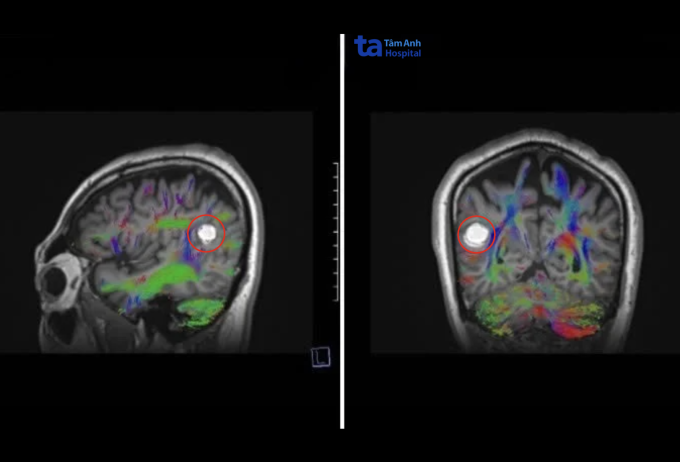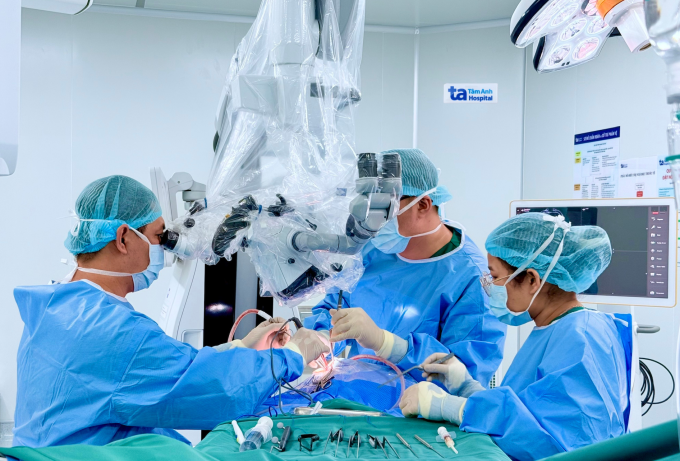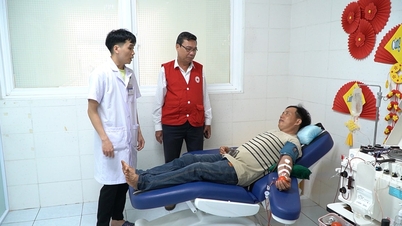Mr. Hung often had a dull headache across his forehead, accompanied by eye fatigue, blurred vision for a few seconds and then it went away on its own. Many times while driving, he suddenly felt dizzy, lightheaded, his eyes darkened as if covered by fog, had to stop and rest for a few minutes to return to normal. Thinking it was due to a relapse of sinusitis, working too much, staying up late, he bought painkillers and used nasal inhalers at home.
A 3 Tesla MRI of the brain at Tam Anh General Hospital in Ho Chi Minh City showed that Mr. Hung had a 2 cm cavernoma deep in the right parietal region (upper middle part of the right cerebral hemisphere) - the area responsible for movement and sensation.
On May 26, Dr. Chu Tan Si, Head of the Department of Neurosurgery, Center for Neuroscience , said that the tumor had ruptured, causing intracranial hemorrhage and forming a blood clot. Around the tumor, there were many old hemorrhages, indicating that blood leakage had been occurring silently for a long time.
"The patient is at high risk of severe hemorrhagic stroke," said Dr. Tan Si, explaining that the times Mr. Hung experienced dizziness and darkness while driving were actually transient partial seizures. These are typical signs but are often overlooked because they occur in a short period of time and are easily mistaken for fatigue, vestibular disorders or low blood pressure.
Surgeons removed the tumor for the patient to limit the risk of serious complications. Microsurgical techniques with the support of the Neuro-Navigation Curve system using artificial intelligence (AI) help doctors accurately determine the location of the tumor and the safe path to the lesion, avoiding invasion into healthy brain tissue. Combined with the new generation Zeiss Kinevo 900 AI microsurgery glasses with high magnification and sharp 3D images, the surgical team separated each small blood vessel, clearly defined tumor boundaries and effectively controlled bleeding. After two hours of surgery, the entire tumor, hematoma and old hemorrhages were removed.
One day after surgery, the patient was awake, had good movement of his limbs, and stable vision. After a week, Mr. Hung was discharged from the hospital, with his motor and sensory functions almost completely restored.
The biopsy results confirmed a benign cavernous hemangioma. This is a type of vascular malformation in the brain or spinal cord, created by abnormal capillaries that clump together to form small blood-filled cavities, shaped like mulberries. The disease is common in people aged 30-50.
According to Dr. Tan Si, many people live with tumors for many years without knowing it, only discovering it when they have seizures, paralysis or intracranial hemorrhage. People with symptoms of prolonged headaches, dizziness, blurred vision, numbness on one side of the body, mild convulsions... that appear briefly but recur many times with increasing frequency and severity should see a neurologist early. Through specialized imaging tests such as MRI, doctors can detect potential lesions early and accurately, thereby having a timely treatment regimen.
(According to Vnexpress.net)
Source: http://baovinhphuc.com.vn/Multimedia/Images/Id/128905/Dot-quy-do-khoi-u-nao-ro-ri-mau




![[Photo] Prime Minister Pham Minh Chinh receives a bipartisan delegation of US House of Representatives](https://vphoto.vietnam.vn/thumb/1200x675/vietnam/resource/IMAGE/2025/5/28/468e61546b664d3f98dc75f6a3c2c880)
![[Photo] Vietnamese and Hungarian leaders attend the opening of the exhibition by photographer Bozoky Dezso](https://vphoto.vietnam.vn/thumb/1200x675/vietnam/resource/IMAGE/2025/5/29/94d8ceca5db14af3bf31285551ae4bb3)
























![[Photo] 12th grade students say goodbye at the closing ceremony, preparing to embark on a new journey](https://vphoto.vietnam.vn/thumb/1200x675/vietnam/resource/IMAGE/2025/5/28/42ac3d300d214e7b8db4a03feeed3f6a)

























































Comment (0)